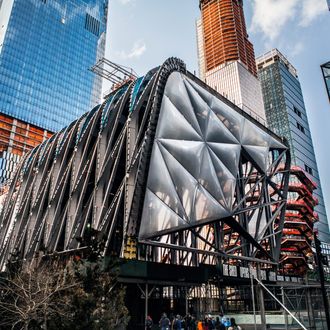
A year before its opening, the Shed, the bubble-wrapped, steel-ribbed arts complex nearing completion at Hudson Yards, remains fuzzed in mystery. The first major commissions are in place, and the menu reads like a list of buzzwords (“immersive,” “multimedia,” “site-specific”), elaborate concepts, and a credit roll of prestigious names. Steve McQueen, the director and producer of 12 Years a Slave, came up with the idea of a multi-concert saga of African-American music, starting with its origins in slavery. (Naturally, Quincy Jones is involved.) Chen Shi-Zheng, who directed The Peony Pavilion at Lincoln Center, is putting together Dragon Spring Phoenix Rise, a spectacular dance-heavy retelling of “a Chinese myth about a sect in Queens that holds the power to extend human life.” (Who knew there were Chinese myths about Queens?) The Shed has declared itself a home for artists in all forms, popular and avant-garde, legendary and obscure, intimate and immense. It’s not just a rental hall but an engine for the creation of new work, with free events, an open-call talent search, and a cache of $5 tickets for each of the paid shows.
To give a little body to these lofty abstractions, A Prelude to the Shed is running until May 13 in a temporary, um, shed across from the construction site. “I didn’t want to open up New York’s first major new arts center in decades and have people say What is that?” artistic director Alex Poots told me. And so he produced the artistic equivalent of a variety pack, in which you never quite know what you’re going to get.
I stopped by on an eerily warm afternoon, when the glass towers along Tenth Avenue focused the heat and glare and noise onto the plaza at West 31st Street like a noxious ray gun. There, the architect Kunlé Adeyemi, who once designed a solar-powered floating school for his flood-prone native Nigeria, has erected a temporary pavilion with no windows and movable walls. Sweaty people were resting on the high-backed upholstered benches that line the building’s exterior. Bangs and hums came from inside.
Mastering my claustrophobia, I stepped into the blacked-out, superheated interior, where an installation by Tino Sehgal was underway. Unaccompanied voices fluttered in the total darkness, quietly singing, trilling, and laying down a percussive beat of crunches and clicks. A hand touched my elbow and led me into the center of the room. I sensed something moving near my face and as my eyes adjusted I began to make out a dancer writhing in slow motion, his arms stirring the air around me. Eventually, I realized that only a handful of audience members were standing around among a troupe that moved sinuously around the room or sat, singing in a circle. It was like stumbling into a beach party where you’re not sure you belong but where everyone is very nice. A couple of performers politely approached the non-participants and wordlessly offered each of us an embrace. Nobody declined.
After 20 minutes, the singer/dancers slithered toward the room’s plywood perimeter and, as they pushed, the wall disassembled into units that slid and turned. Daylight encroached, and the idlers sitting on the benches outside found they were being scooted in various directions. Inside and outside merged, the architecture dissolved, the audience regrouped, dancers flowed out onto the open plaza, and one piece bled into another. The PA system launched a song by Azealia Banks, and the dancers Roderick George and Josh Johnson exploded William Forsythe’s Pas de deux cent douze (212 pas de deux, get it?). Somewhere along the line, the vibe had changed from make-yourself-at-home to don’t-try-this-at-home.
This fluid exchange between architecture and various art forms has its roots in the Fun Palace, a never-built but enduringly influential 1960s scheme conceived by the British architect Cedric Price and the theater director Joan Littlewood. In that project — as a team of docents on the plaza explained — visitors would wander through an Erector Set–style structure, all steel trusses and open walls, and graze on amusements and cultural offerings. The Shed’s architects, Diller Scofidio + Renfro with Rockwell Group, have tried to embed Price’s spirit into the new building. Walls slide open, seating risers get reconfigured, two theaters can merge into one, blackout drapes can turn a day-lit gallery into a black box, and, most visibly, the shell rolls out to create a vast second enclosure. All these moving parts should create a sense of connection and ferment, that essentially New York feeling that there’s always more going on than you could possibly absorb.
It’s still hard to know whether, when the building finally opens next year, this new institution with its hefty budget and heavy-hitting board will be able to maintain that air of scruffy flexibility. Schedules and disciplines and targeted marketing have a way of imposing their own logic on the interdisciplinary spirit. It’s also unclear whether the newcomer will compete for talent and audiences with more specialized institutions like Lincoln Center, the Armory, or the New Museum. But this drop-in program offers an exciting peek into the Shed as a creative greenhouse where the arts get grafted, hybrids are bred, and the culture’s DNA is reshuffled into fresh expressions.






























